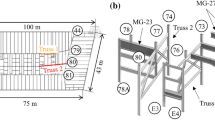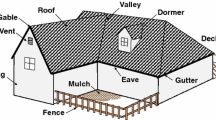Abstract
The National Institute of Standards and Technology (NIST) conducted an extensive investigation of the collapse of the three tall World Trade Center (WTC) buildings. A central part of this investigation was the reconstruction and understanding of the initiation and spread of the fires. This paper describes the reconstruction of the fires, the thermal environment they created within the buildings, and the raising of the temperatures of the structural components. NIST analyzed thousands of documents, interviews, photographs, and videos to obtain information on the layout of the floors and the progress of the fires. Experiments provided information on the factors likely to have determined the fire growth. Simulations using the Fire Dynamics Simulator gave good agreement with the fire spread as observed at the windows. Imposition of the probable thermal environment on the structural steel produced maps of the probable temperature profile of the steel as the fires progressed. For WTC 1 and WTC 2, even in the vicinity of the fires, it was unlikely that the columns and floor trusses with intact insulation heated to temperatures where significant loss of strength occurred. This was in part due to the short time between aircraft impact and building collapse. There were regions of the towers in which the loss of structural strength of floors and columns, whose insulation had been damaged by aircraft impact, was likely. For WTC 7, even though the insulation was intact, the long periods of heating resulted in floor components whose temperatures exceeded 600°C, but columns did not exceed 300°C.


















Similar content being viewed by others
Notes
This is a publication of the National Institute of Standards and Technology (NIST) and is not subject to copyright in the United States. NIST is a nonregulatory agency of the U.S. Department of Commerce. The purpose of NIST investigations is to improve the safety and structural integrity of buildings in the United States. NIST does not have the statutory authority to make findings of fault nor negligence by individuals or organizations. By law, no part of any report resulting from a NIST investigation into a building failure or from an investigation under the National Construction Safety Team Act may be used in any suit or action for damages arising out of any matter mentioned in such reports.
The policy of NIST is to use the International System of Units in all publications. In this document, however, the primary units are presented in either metric units or the inch-pound system, whichever is prevalent in the discipline.
Subsequent to the reconstruction of the fires in the three tall WTC buildings, extensive upgrades have been made to FDS. The effects of these on the outcome of the fire simulations and the importance of any changes in fire outcome on the structural decay of the buildings are matters for speculation that could only be resolved by performing the entire set of computations with a particular updated version of FDS. The resources needed for this type of re-examination are substantial, and such computations have not been performed.
References
McAllister TP, Sadek F, Gross JL, Averill JD, Gann RG (2012) Overview of the structural design of World Trade Center 1, 2, and 7 buildings. Fire Technol (this issue). doi:10.1007/s10694-012-0285-6
Gann RG ed (2005) Federal building and fire safety investigation of the World Trade Center disaster: final report on the collapse of the World Trade Center towers. NIST NCSTAR 1, Gaithersburg
Gann RG ed (2008) Federal building and fire safety investigation of the World Trade Center disaster: final report on the collapse of World Trade Center 7. NIST NCSTAR 1A, Gaithersburg
McAllister T ed (2002) World Trade Center building performance study: data collection, preliminary observations, and recommendations. FEMA 403, Federal Emergency Management Agency, Washington, DC
McAllister TP, Sadek F, Gross JL, Kirkpatrick S, MacNeill RA, Zarghamee M, Erbay OO, Sarawit AT (2012) Structural response of World Trade Center buildings 1, 2 & 7 to impact and fire damage. Fire Technol (this issue). doi:10.1007/s10694-012-0289-2
Pitts WM, Butler KM, Junker V (2005) Federal building and fire safety investigation of the World Trade Center disaster: visual evidence, damage estimates, and timeline analysis. NIST NCSTAR 1-5A, Gaithersburg
McAllister T, Gann RG, Averill JD, Gross JL, Grosshandler WL, Lawson JR, McGrattan KB, Nelson HE, Pitts WM, Prasad KR, Sadek FH (2008) Federal building and fire safety investigation of the World Trade Center disaster: structural fire response and probable collapse sequence of World Trade Center Building 7. NIST NCSTAR 1-9, vol 1, Gaithersburg
Lew HS, Bukowski RW, Carino NJ (2005) Federal building and fire safety investigation of the World Trade Center disaster: design, construction, and maintenance of structural and life safety systems. NIST NCSTAR 1-1, Gaithersburg
Gann RG, Hamins A, McGrattan KB, Mulholland GW, Nelson HE, Ohlemiller TJ, Pitts WM, Prasad KR (2005) Federal building and fire safety investigation of the World Trade Center disaster: reconstruction of the fires in the World Trade Center towers. NIST NCSTAR 1-5, Gaithersburg
Ohlemiller TJ, Mulholland GW, Maranghides A, Filliben JJ, Gann RG (2005) Federal building and fire safety investigation of the World Trade Center disaster: fire tests of single office workstations. NIST NCSTAR1-5C, Gaithersburg
Hamins A, Maranghides A, McGrattan KB, Ohlemiller TJ, Anleitner R (2005) Federal building and fire safety investigation of the World Trade Center disaster: experiments and modeling of multiple workstations burning in a compartment. NIST NCSTAR 1-5E, Gaithersburg
Hamins A, Maranghides A, McGrattan KB, Johnsson E, Ohlemiller TJ, Donnelly M, Yang J, Mulholland GW, Prasad KR, Kukuck S, Anleitner R, McAllister T (2005) Federal building and fire safety investigation of the World Trade Center disaster: experiments and modeling of structural steel elements exposed to fire. NIST NCSTAR 1-5B, Gaithersburg
Carino NJ, Starnes MA, Gross JL, Yang JC, Kukuck S, Prasad KR, Bukowski RW (2005) Federal building and fire safety investigation of the World Trade Center disaster: passive fire protection. NIST NCSTAR 1-6A, Gaithersburg
Gann RG, Riley MA, Repp JM, Whittaker AS, Reinhorn AM, Hough PA (2005) Federal building and fire safety investigation of the World Trade Center disaster: reaction of ceiling tile systems to shocks. NIST NCSTAR 1-5D, Gaithersburg
Gross JL, McAllister T (2005) Federal building and fire safety investigation of the World Trade Center disaster: structural fire response and probable collapse sequence of the World Trade Center towers. NIST NCSTAR 1-6. National Institute of Standards and Technology, Gaithersburg
McAllister TP, Gann RG, Averill JD, Gross JL, Grosshandler WL, Lawson JR, McGrattan KB, Nelson HE, Pitts WM, Prasad KR, Sadek FH (2008) Federal building and fire safety investigation of the World Trade Center disaster: structural fire response and probable collapse sequence of World Trade Center building 7. NIST NCSTAR 1-9, vol 2, Gaithersburg
McGrattan KB, Bouldin C, Forney G (2005) Federal building and fire safety investigation of the World Trade Center disaster: computer simulation of the fires in the World Trade Center towers. NIST NCSTAR 1–5F, Gaithersburg
Baum HR, Rehm RG (2005) A simple model of the World Trade Center fireball dynamics. Proc Combust Inst 30:2247–2254
Atreya A (1984) Pyrolysis, ignition and fire spread on horizontal surfaces of wood. Report NBS-GCR-83-449, National Bureau of Standards, Gaithersburg
Ritchie SJ, Steckler KD, Hamins A, Cleary TG, Yang JC, Kashiwagi T (1997) Effect of sample size on the heat release rate of charring materials. In: Hasemi Y (ed) Fire safety science—proceedings of the fifth international symposium. International Association of Fire Safety Science, Boston
Di Blasi C (1998) Physico-chemical processes occurring inside a degrading two-dimensional anisotropic porous medium. Int J Heat Mass Transf 41:4139–4150
Fredlund B (1988) A model for heat and mass transfer in timber structures during fire: a theoretical, numerical and experimental study. Report LUTVDG (TVBB-1003), Department of Fire Safety Engineering, Lund University, Sweden
Novozhilov V, Moghtaderi B, Fletcher F, Kent JH (1996) Computational fluid dynamics modelling of wood combustion. Fire Saf J 27:69–84
Parker WJ (1989) Prediction of the heat release rate of Douglas Fir. In: Fire safety science—proceedings of the 2nd international symposium. International Association of Fire Safety Science
Prasad KR, Baum HR (2005) Federal building and fire safety investigation of the World Trade Center disaster: fire structure interface and thermal response of the World Trade Center towers. NIST NCSTAR 1-5G, Gaithersburg
Gayle FW, Fields RJ, Luecke WE, Banovic SW, Foecke T, McCowan CN, Siewert TA, McColskey JD (2005) Federal building and fire safety investigation of the World Trade Center disaster: mechanical and metallurgical analysis of structural steel. NIST NCSTAR 1-3, Gaithersburg
Stern-Gottfried J (2011) Travelling fires in building design. Ph.D. thesis, University of Edinburgh. http://hdl.handle.net/1842/5244
Author information
Authors and Affiliations
Corresponding author
Additional information
This is a publication of the National Institute of Standards and Technology and is not subject to copyright in the United States.
Harold E. Nelson is deceased.
Thomas J. Ohlemiller is retired.
Rights and permissions
About this article
Cite this article
Gann, R.G., Hamins, A., McGrattan, K. et al. Reconstruction of the Fires and Thermal Environment in World Trade Center Buildings 1, 2, and 7. Fire Technol 49, 679–707 (2013). https://doi.org/10.1007/s10694-012-0288-3
Received:
Accepted:
Published:
Issue Date:
DOI: https://doi.org/10.1007/s10694-012-0288-3




